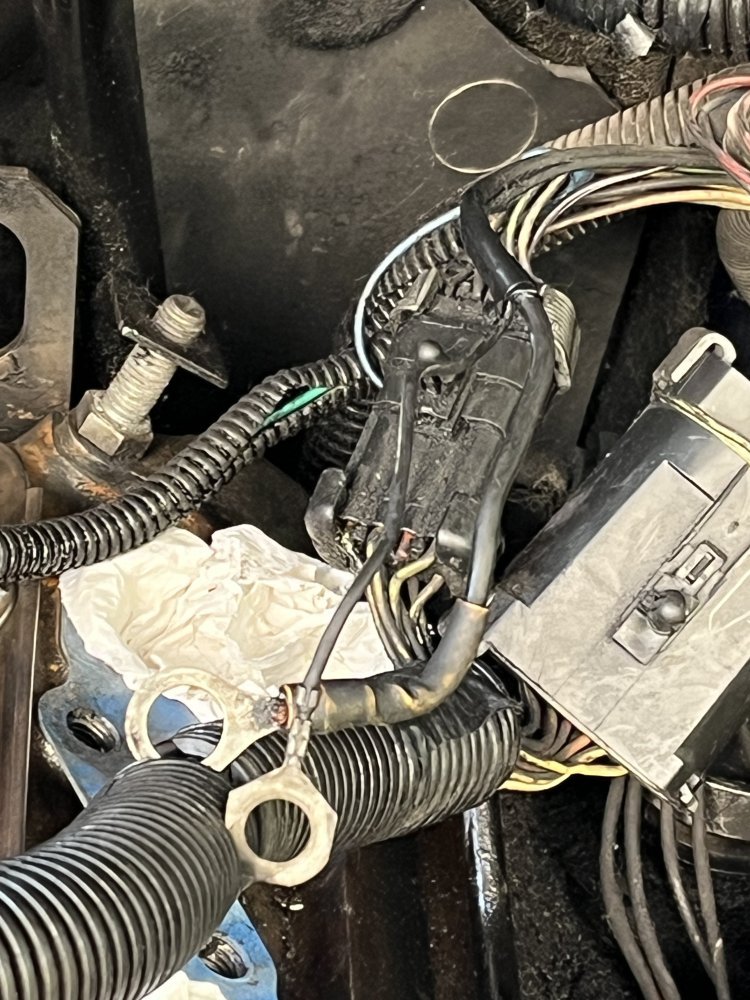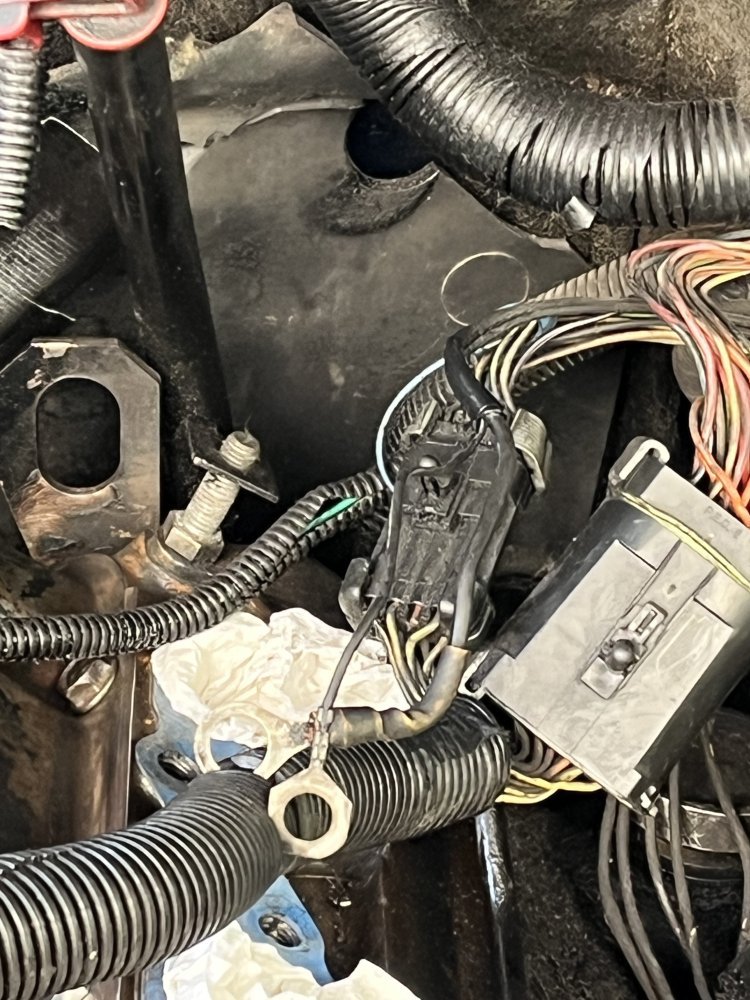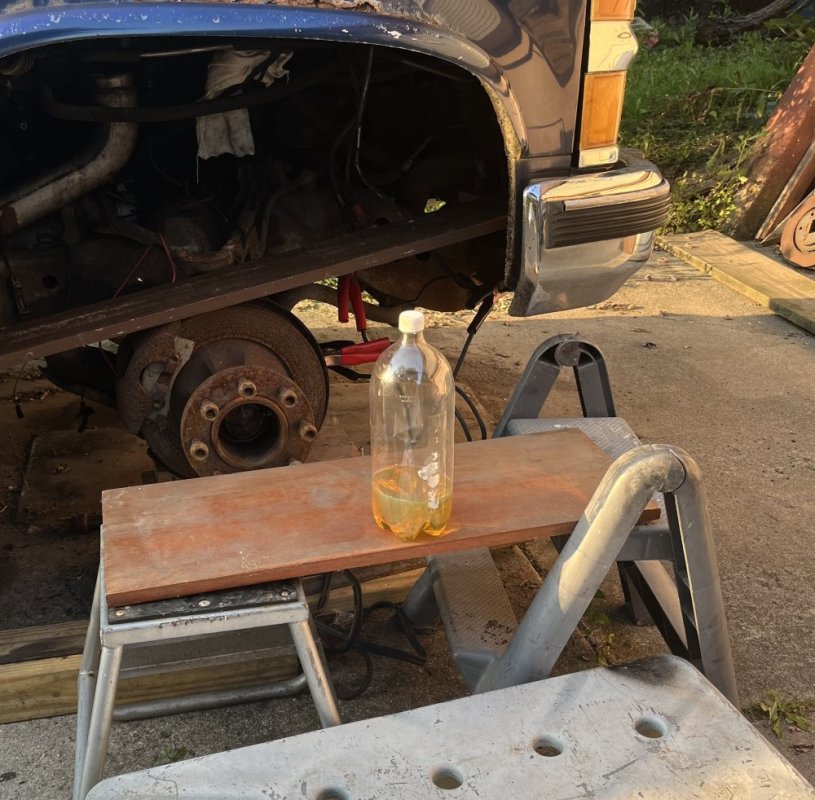Getting ready to reinstall the injector lines…a bunch of wiring and vacuum lines not hooked up when I bought the truck 1995 c3500 6.5 turbo diesel Dually and not sure where or what these 2 electrical connections go to can anyone help? Auto transmission maybe grounds but would like to be sure.. thanks panran
Navigation
Install the app
How to install the app on iOS
Follow along with the video below to see how to install our site as a web app on your home screen.
Note: This feature may not be available in some browsers.
More options
-
Welcome to The Truck Stop! We see you haven't REGISTERED yet.
Your truck knowledge is missing!
- Registration is FREE , all we need is your birthday and email. (We don't share ANY data with ANYONE)
- We have tons of knowledge here for your diesel truck!
- Post your own topics and reply to existing threads to help others out!
- NO ADS! The site is fully functional and ad free!
Problems registering? Click here to contact us!
Already registered, but need a PASSWORD RESET? CLICK HERE TO RESET YOUR PASSWORD!
You are using an out of date browser. It may not display this or other websites correctly.
You should upgrade or use an alternative browser.
You should upgrade or use an alternative browser.
Eye connectors
- Thread starter panran
- Start date
ak diesel driver
6.5 driver
Hard to see in your pic but they definetley look like grounds, should be 3 of them attached to the rear crossover block off plate.
dbrannon79
I'm getting there!
ak diesel driver and dbrannon79 thanks for the reply…during a beer break I looked up grounds and there were pics by Turbine Doc and it seems to be like one I saw bolted to intake manifold.. I will have to look for the 3rd one…I was posting on diesel place and someone mentioned this was an excellent place to get help and it delivered…thanks again
Will L.
Well-Known Member
That is correct.
Be sure to clean the connection points well before attaching. Inconsistent grounds create a world of headaches.
Welcome btw.
Be sure to clean the connection points well before attaching. Inconsistent grounds create a world of headaches.
Welcome btw.
ak diesel driver
6.5 driver
be a better ground if it is attached to a dry hole vs a wet with coolant hole
dbrannon79
I'm getting there!
Ask away. here or a new thread. it's pretty relaxed here and we tend to talk about anything and everything under the sun LOL
Okay..so I am connecting the injector lines and darkness and mosquitoes paused that got 4 tightened up…so the thought of testing for leaks before putting intake on…so the truck hasn’t ran in over a year maybe longer, but last week I had the idea of trying to pump oil to the rockers before reassembling but didn’t want to burn up the starter or kill the battery…so today while moving the fuel filter housing around fuel came out of the line going to the injector pump, only a little, but looked like the fuel I bought to pop test the injectors…so can I.. probably should I jump the lift pump to see what the fuel looks like coming out of the fuel hose coming from the filter housing? And then can I do it without all the electrical hooked up and just use the batteries to pump it by jumping off the fuse box.
dbrannon79
I'm getting there!
on the 95, no the only way to "jump" or test the lift pump is to use the PCM connector under the dash. here is where everyone will recomend you install the relay mod on the oil pressure sender while you have things apart. Leroy, a supporting vender and member here, sells a complete ready to go harness if your not wanting to splice in a relay and add to the factory harness. I made my own and also tied it into the glow plug relay so that the LP will prime when the glows are warming. I believe Leroy's harness also does this.
connect a positive lead to pin G to manually turn on the lift pump. Pic below is a general pic and not specifically for the diesel variety.
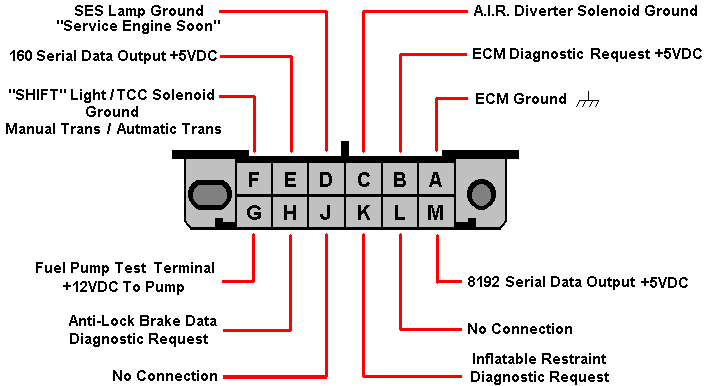
connect a positive lead to pin G to manually turn on the lift pump. Pic below is a general pic and not specifically for the diesel variety.

dbrannon79
I'm getting there!
Also just a word of caution. you mentioned checking for leaks with the intake off. you can run the engine with the intake off BUT.... make dam sure there is nothing that can possibly get sucked into the intake ports of the head, NO oil and NO fuel leaks ether. or you will be looking for another engine after scrambling to kill a run away diesel and then cleaning you shorts out!
make sure all of the steel injector lines on the IP (injector pump) are tight and the rubber hoses are not leaking after pressurizing the fuel lines using info in my last post. the factory FFM (fuel filter manager) tend to leak with age at the bottom due to the plastic and old o-rings so check that as well before trying to crank the engine. You can leave the steel line loose on the injectors to bleed out the air, when you see fuel coming out of each line nut at each injector, tighten them all up and it should start right up!
I normally will install the lower half of the intake and use a good flashlight looking to leaks on the IP lines under it. this way you can use a board to cover the opening of the intake in the event of a run away situation. I'm sure you know already, but remember these engines don't use a "throttle" or butterfly to control the RPM, the intakes are wide open. the amount of fuel going into the combustion chamber controls the RPM.
make sure all of the steel injector lines on the IP (injector pump) are tight and the rubber hoses are not leaking after pressurizing the fuel lines using info in my last post. the factory FFM (fuel filter manager) tend to leak with age at the bottom due to the plastic and old o-rings so check that as well before trying to crank the engine. You can leave the steel line loose on the injectors to bleed out the air, when you see fuel coming out of each line nut at each injector, tighten them all up and it should start right up!
I normally will install the lower half of the intake and use a good flashlight looking to leaks on the IP lines under it. this way you can use a board to cover the opening of the intake in the event of a run away situation. I'm sure you know already, but remember these engines don't use a "throttle" or butterfly to control the RPM, the intakes are wide open. the amount of fuel going into the combustion chamber controls the RPM.
dbrannon79
I'm getting there!
If your handy with installing a relay and DIYing for the lift pump, I will dig around and find the diagram I used when I did mine. the OPS (oil pressure sensor) is located behind the FFM down in the valley of the engine near the back of the drivers side head. there are three wires to it. one to the gauge, one battery hot in and one going to the lift pump. the way GM designed it, there is power to the OPS all the time even when the key is off. as long as there is oil pressure, the LP will run. it would have been nice if GM made it were the key would kill power to it. the relay mod is to fix the fact that the tiny contacts in the OPS can't handle the amperage the LP pulls and over time will ether weld them selves together killing the LP and the batterys or just not work anymore where you don't know it until the IP dies a slow painful death costing you a grand or more to fix.
WOW..a lot to consider my first diesel…never heard of what a runaway diesel meant thanks for the warning I’ll have to try to research that…. I’m not going to try and start without intake installed..was just thinking I could get fuel pumping to make sure it not contaminated before moving forward…not planning on using the truck for a while just wanted to see if it fires up to assure I didn’t get ripped off…have a lot of work to still do to get it road ready but have to leave for Colorado in a week or two until January or February…another question came up..anyway to connect a kill switch?
jrsavoie
Recruit
Mine were attached to the wet hole. I should have changed that. I think I did on one vehicle. But I changed it, to be the same as another vehicle. Not sure which way I went.be a better ground if it is attached to a dry hole vs a wet with coolant hole
I lost good continuity to the studs a couple times
dbrannon79
I'm getting there!
I did not know it made a difference connecting the grounds on a wet one vs dry. I think in the beginning mine was connected to the same stud as the trans tube (coolant block off plate) then later when I cleaned them for the first time I moved over to the intake stud just for convenience making them easier to get to.
Thanks but not quite sure sure what a wet hole is…But I did get the 2 lower injection line on the pump I tried to find a 12 point flare wrench or crows foot local but no luck they came off a lot easier. I’ll try to tighten them up in the morning and then test them to see if they leak before putting the intake on.. I found the hack to jump the lift pump and drained about 10 ounces till the air bubbles stopped and took a picture so I’m not sure if the fuel looks alright maybe someone can zoom in and look..figure to bleed the filter one more time and hook it up to the injector pump and bleed each injector then if I have time do intake and grounds..at least I want fuel to the injectors if I leave it sit into winter.
Attachments
Will L.
Well-Known Member
Wet hole is a bolt or stud that goes into a threaded hole that penetrates into a coolant passage. So in order to seal the coolant some type of silicone is required. The sealant impedes the metal to metal connection and can be the source of a faulty ground.
As for air (aeration) of the fuel- you should replace the 1/4” diameter ip (injection pump) return hose. It comes out the front top of the ip, is like an upside down “U” shape and is around 5” long. Many of us used the clear hose available at any hardware store sold by the foot. It isn’t really rated as fuel line and needs to be replaced every 3-5 years based on your environment. The better choice is the clear fuel line from fuelline.com. It is rated for 25psi, and can handle any fuel including nitromethane and any alcohols.
With the engine running or attempting to run you simply watch for fuel flow. Any bubbles, or contamination is a sign to repair that problem BEFORE any others diagnosing or issue.
It is a simple job, takes longer to buy the hose than install it and is invaluable long term.
Install it and replace with more clear when needed from it getting hard where it may crack. Never run the black hose again.
The other thing that is a wise investment is something many people (myself included) believe should have been stock:
A tapping port (T fitting) made of metal so you can add a fuel pressure gauge AT THE IP INLET. Many many ip that were good have been misdiagnosed and replaced to only have the same issues- later to find deteriorating fuel lines or weak lift pump.
This is the only place I know of selling the correct fitting and advertising it for the ds4 ip. You could search it out yourself and save a few bucks- but not sure the savings is worth the time.
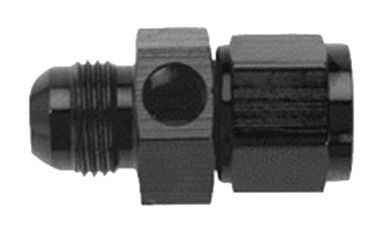
 modmafia.com
Mount the pressure gauge where you see it when driving.
modmafia.com
Mount the pressure gauge where you see it when driving.
Stanandyne recommends 8-14 psi. Anything below 5 isn’t healthy and getting to zero or negative pressure is massively damaging to the ip. The price of the gauge is basically an insurance policy to save the life of the ip.
I tend to overdo things and am adding a second sensor that will be before the filter so I can see by comparison when the filter needs replacement. I will only use one gauge and have the two wires go to a momentary switch so I can read the pre filter side- then it will default to ip pressure. I used to always run a mechanical gauge in the cab- but simple never considered the fire potential. That was removed and won’t be reinstalled.
As for air (aeration) of the fuel- you should replace the 1/4” diameter ip (injection pump) return hose. It comes out the front top of the ip, is like an upside down “U” shape and is around 5” long. Many of us used the clear hose available at any hardware store sold by the foot. It isn’t really rated as fuel line and needs to be replaced every 3-5 years based on your environment. The better choice is the clear fuel line from fuelline.com. It is rated for 25psi, and can handle any fuel including nitromethane and any alcohols.
With the engine running or attempting to run you simply watch for fuel flow. Any bubbles, or contamination is a sign to repair that problem BEFORE any others diagnosing or issue.
It is a simple job, takes longer to buy the hose than install it and is invaluable long term.
Install it and replace with more clear when needed from it getting hard where it may crack. Never run the black hose again.
The other thing that is a wise investment is something many people (myself included) believe should have been stock:
A tapping port (T fitting) made of metal so you can add a fuel pressure gauge AT THE IP INLET. Many many ip that were good have been misdiagnosed and replaced to only have the same issues- later to find deteriorating fuel lines or weak lift pump.
This is the only place I know of selling the correct fitting and advertising it for the ds4 ip. You could search it out yourself and save a few bucks- but not sure the savings is worth the time.

Fuel Pressure Gauge Adapter
A fuel pressure gauge is essential to monitoring the health of your fuel delivery system. Mod Mafia makes it easy to add this important gauge to your Hummer / H1…
 modmafia.com
modmafia.com
Stanandyne recommends 8-14 psi. Anything below 5 isn’t healthy and getting to zero or negative pressure is massively damaging to the ip. The price of the gauge is basically an insurance policy to save the life of the ip.
I tend to overdo things and am adding a second sensor that will be before the filter so I can see by comparison when the filter needs replacement. I will only use one gauge and have the two wires go to a momentary switch so I can read the pre filter side- then it will default to ip pressure. I used to always run a mechanical gauge in the cab- but simple never considered the fire potential. That was removed and won’t be reinstalled.
dbrannon79
I'm getting there!
the fuel in your bottle looks clean and isn't too discolored that I can tell. as long as there is no water or particles in it or looks like there is any algae (slime) growing you should be good.
on getting a wrench on the IP lines. it's not easy, there is a trick to it fitting a open end wrench in there to tighten each one. I somehow managed to get them in on mine but had to have the nuts pulled back on each line and started at the two lowest lines and went up each side from there. just be careful not to bend any of the IP lines or put stress on the IP housing with the wrench. a crows foot does make things much easier.
on getting a wrench on the IP lines. it's not easy, there is a trick to it fitting a open end wrench in there to tighten each one. I somehow managed to get them in on mine but had to have the nuts pulled back on each line and started at the two lowest lines and went up each side from there. just be careful not to bend any of the IP lines or put stress on the IP housing with the wrench. a crows foot does make things much easier.
Thanks important info…I kind of put 2+2 together after I posted as some other members mentioned about coolant passage…I am sometimes slow at comprehension have to read the same sentence 4 or 5 …so I did buy 2’ of 1/4” 5/16” and 3/8” clear hose the other day at the hardware store just so I wouldn’t have to go back and forth but I will have to take a look at the ip tomorrow to see where it goes..sorry I have to take baby steps want to get it right and sometimes more questions..so the truck hasn’t been started in over a year could that be the reason for air when bleeding I didn’t open the fuel filter bleeder just straight to the line going to the ip.. I promised my wife I would be in Colorado around Labor Day..get so involved in wrenching its hard but the decision is my wife

